#seed collecting
Explore tagged Tumblr posts
Text
Preparing for a seed swap! Finally, I can be as generous as I like without having to worry about postage.

since I misplaced my assortment of small seed envelopes, I ripped a bunch of pages out of a seed catalog and folded them into envelopes with the sides taped shut. I can fit an entire season of seeds in a single altoid tin!
52 notes
·
View notes
Text
Collecting Milkweed Seeds - All Facts, All Seeds, No Fluff
(OK but please also consider I'm not an ~expert~ I'm not a ~scholar~ I'm just a nerd on Tumblr who really likes milkweed and wanted to make a fun lil post about it)
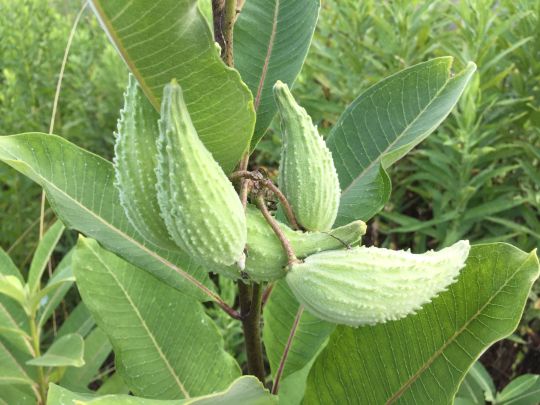
[Image ID: a green, leafy common milkweed plant (Asclepias syriaca) with five large, ovalish and bumpy green seed pods. The seed pods are currently unopened.]
It’s fall, which means if you haven’t seen them already, now’s the time that milkweed plants will start producing seed pods! (Well, technically, they’re called follicles, but fuck it they’re seed pods). Each pod has dozens of seeds inside, some species can even have up to 200 seeds, so even collecting just a few can be a good way to boost your pollinator gardening efforts big time! What you do with them then is up to you--adding life to your backyard garden, sharing with friends, making seed bombs--but first you’ve gotta collect them.
The first thing you want to do is identify your milkweed plants--in an ideal world, you’d be able to tell precisely what kind of milkweed you’re collecting from (so you can know precisely what growing conditions that species prefers.) But when they’re dying back, forming pods, and releasing their seeds, it can be hard to tell. It helps to visit sites early, to know what milkweeds are there, and while you’re there you might even find some forming pods.
It can be helpful to band off the pods early! This will keep the seeds from escaping, so you can come back later and collect them! I would only do this for a couple of pods--each pod has a lot of seed in it, so only taking one or two from each plant should still net you plenty of rewards! When I’m doing this in my backyard, I tend to use rubber bands--the size of rubber band you’ll need varies depending on the species. I’ve also seen people use the lacy-looking jewelry bags to a similar effect--if the pod splits open, all the seeds get trapped in the bag!

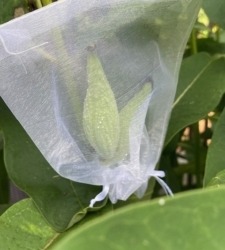
[Image ID: the first image is of appears to be swamp milkweed (Asclepias incarnata) with about fifteen long, green, smooth and pointed seed pods. Most of the pods have small black rubber bands wrapped around the midsections. The second image is of what appears to be common milkweed (Asclepias syriaca) with two large, ovalish and bumpy green seed pods. A white fine mesh bag has been tied over the pods.]
For people who want to get seeds from unopened pods, you have to be very careful not to force open a pod that isn’t ready--otherwise, the seeds inside won’t fully develop. How do you tell if a pod is ripe? There’s a seam in each pod, and it should open fairly easily with minimal pressure if it’s basically ready. If you’re basically prying it open, you’re too early. The seeds inside should be a nice dark color, and be plump in the middle--if they’re creamy colored or light orange, you’re too early. There may be some undeveloped seeds in each pod (I am talking maybe 1 to 3 here), but if the majority of them are ready, you’re good to go!

[Image ID: a tropical milkweed (Asclepias curassavica) seed pod that has been opened at the seam, revealing dark brown seeds and lots of creamy white floss. Four seeds are floating away from the pod on fluffy white comas. The pod is being held between a white person's fingers.]
I’ve also seen people who go late late late into the season, after most of the pods have already fully split off and released their seeds. Some of the seeds occasionally stay in the pod, so they’ll take the leftovers that didn’t get scattered after winter passes. That’s a fair strategy! I prefer to get mine way early on, so I can get a clear ID of what kind of milkweed it is (some will flower and produce pods at the same time), but if you already got an ID early in the season and then come back later this can also work! But…

[Image ID: several dried brown seed pods have opened fully, releasing a cloud of milkweed floss with seeds attached. Some seeds are still in the pods, but many are primed to float away.]
There is, however, one thing that tends to be a bit annoying about collecting milkweed seeds--and that’s the fluff. These fluffy white bits attached to the seed--called comas--function similarly to the iconic fluffy dandelion seed. A milkweed seed’s coma allows it to float through the air and on the water until it (hypothetically) reaches bare soil or an otherwise suitable start to settle down and germinate. If you’re collecting the seeds for later use, though, that same coma can mean your milkweed seeds are traveling through the air and away from where you’re collecting them, or all over your apartment once you get them home. Removing the comas by hand is an option, but tedious, and still leads to a nice pile of fluffy that will get airborne at the first gust of wind. At the end of the day, for many people trying to collect milkweed seeds, the coma is just an annoying part they dread.
Fortunately, there are plenty of ways to collect milkweed seeds without having to deal with the comas long-term!
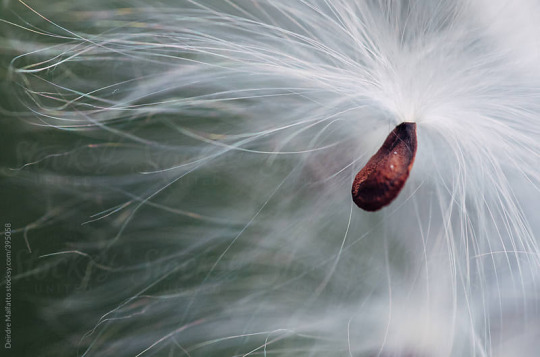
[Image ID: A single brown milkweed seed floating on a comparatively huge mess of white fibers.]
Method 1
So this is my favorite method because it's honestly one of the simplest and easiest once you get used to it. You open the pod, grip the top part of the middle ‘pith’ section tight, and gently scrape off the seeds into a bowl or bag. This leaves you with almost no fluff in your collection bin, and you can then toss the middle fluffy part--or I’ve heard of people collecting milkweed fluff for spinning! Most of the videos I’ve seen on it use common milkweed or other large milkweed pods as an example--however, I’ve successfully done this with smaller milkweed pods like A. curassavica as well.
youtube
Method 2
This method is one I’ve used in the past. Take the seeds and fluff and put them into a bag (paper or plastic) and add a coin or two. Shake the bag around--a lot. The coin will dislodge the comas from the seeds. The seeds will then drop to the bottom of the container, and the fluff will float around on the top. I’ve also seen this with buckets and blocks, like in the video below!
Method 3
I’ve seen a handful of people discuss burning the floss of the seeds! Apparently the seeds themselves aren’t damaged badly by the fire, though honestly this is a method that I am simply too anxious to try myself.
youtube
Method 4
This was a method I found while I was looking for other methods people have done. Apparently, you can just roll the pod between your hands and it’ll work to dislodge the seeds? I may have to try it next time!
youtube
Hopefully this advice is helpful for you all! I know collecting seeds was a hassle for me before I learned my favorite method. If I had a nickel for every time I got yelled at for releasing milkweed fluff into the house...
If you've got a method that I haven't heard about yet, let me know!! I'm always down to learn more about milkweed, and it can also help someone else down the line!
#milkweed#asclepias#seed saving#seed collecting#pollinator garden#outdoor gardening#gardening#flowers#ani rambles#out of queue#i think this was my first time doing image descriptions??? if they suck ass let me know and I'll Make Adjustments As Recommended#i've seen people talk about spinning the milkweed floss??? but I saw online that it was too brittle to be spun????#but either way if you wanna save the floss and do Stuff with it go for it#did you know. or actually this is me functioning from memory.#but if I recall correctly I believe in either the WWI era or the WWII era#people would pay kids to go around fields collecting milkweed seed pods and pay them by the pound#and then they'd take the floss and use it to fill life jackets for soldiers?#i think this was less of a 'extorted child labor sweat shop' deal and more of a like#'hey kids wanna earn some cash and also be a Patriotic Citizen? go find some seed pods and we'll give you money'#which i guess many people WOULD consider an Extorted Child Labor kinda deal but like#idk seems like a chill deal to me#anyways hope you guys like this post#Youtube
222 notes
·
View notes
Text
gardening update || 12/01/24 🏡🌱🌼
was out in the garden today to water a bit and we've got good news and bad news...
bad news is one of my 3 veggie/crop raised beds is just absolutely wilting... i have no idea why bc it wasn't like this the last time i checked two days ago, but now everything looks so sad and miserable



i am very confused as to why... am i over watering?? was it too cold??? do they not have enough mulch??? should i buy more straw to mulch them more???? aaaaaaa i have no idea please help 😭😭
onto the good news...



i harvested a ton of different flower seeds in the garden! we have violas, coneflower, zinnia, and my pink cosmos! i definitely still have more to learn about seed collecting and seed saving, but i'm still just beginning and i have time to learn & hone the skill!
the viola seeds are really interesting, they remind me of one of the monster things from stranger things lol. i only caught glimpses of the show when my dad was watching it, but they remind me of these guys:

#hobby: gardening#gardening#gardenblr#garden blog#garden#raised garden beds#garden bed#seed saving#seed collecting#seeds#seed#viola#violas#coneflower#pink cosmos#cosmos#zinnia
18 notes
·
View notes
Text
It’s seed collecting season in my poison garden so here is some poppy seed ASMR. Sound on!
#bane folk#opium poppy#breadseed poppy#poisonous plants#toxic plants#medicinal plants#seed saving#seed collecting#poison garden#poison path
92 notes
·
View notes
Text
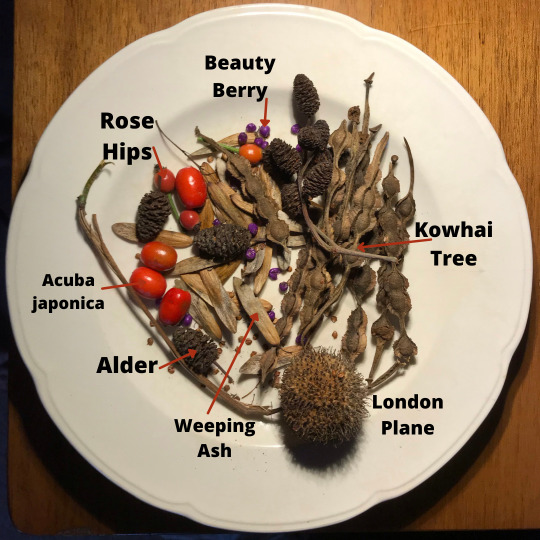
Seeds are miraculous little things if you ponder them... They contain the potential for a whole plant in a biological "time capsule". As gardeners in Europe and the Northern Hemisphere start planning their seed orders, it's a perfect time to learn more about germination. Germination is the term for an organism growing into a whole adult plant from a seed or a spore, and it is used scientifically to talk about fungi and bacteria as well as plants. A typical plant seed contains a plant embryo, food reserves, and a seed coat. Depending on the species, mature seeds can be stored for years since the plant embryo is in a dehydrated state of suspended animation.
In nature, germinating at the wrong time in unfavourable conditions could spell disaster for the new plant. Seeds rely on the signals from water, temperature, oxygen, and light.
Soaking seeds is an excellent way to start germination. The seed coat is gently scarified with sandpaper or a nail file to break the watertight seal and allow water to enter the seed interior. The seeds often double in size as their tissues soak up the water in a process called imbibition. Water activates hydrolytic enzymes which start the seed's biological metabolism.
Tree seeds from temperate climates usually need cold stratification to germinate. The seed is kept in soil at low temperatures around 4 C (like a fridge) for several months before returning to room temperature. This temperature change tells the seed winter has passed and spring has arrived. Simply leaving potted seeds in a cold frame overwinter is ideal in Europe.
Seeds along need oxygen since seedlings do aerobic respiration until they're mature enough to start photosynthesising. Hard packed or waterlogged soil may contain insufficient oxygen and stop seeds from sprouting. Many tree seeds need exposure to light through a thin layer of soil to let them know that there's a "clearing" in the forest.Most kitchen garden seeds do well with soaking and exposure to warm temperatures since they are originally tropical plants.
This plate of seeds was collected in January in Hyde Park, London.
#seeds#germination#seedstarting#PlantBiology#plantscience#seedstorage#stratification#TreeSeeds#katia_plantscientist#gardening#gardeningtips#plants#plantfacts#stratification#seedsaving#seedstartingtime#semillos#nuts#fruits#plantlife
#katia plant scientist#botany#plant biology#plants#plant science#seeds#seed starting#seed saving#stratification#seed collecting#plant#plant aesthetic#plant scientist#plantblr#plantcore#planting#gardening#tree seeds#gardening tips
24 notes
·
View notes
Text

My short vacay had to be cut shorter but I made use of my last day bus hopping as I had planned out to go to a comic store then to go seed hunt at the Guelph Arboretum.
I didn't realize they had female ginkgo trees! So with that I got Ginkgo nuts, Wahoo seeds, and Kentucky Coffee Tree pods. Not bad considering how little time I could afford to go through the Arboretum.
I feel proud to have plotted out my trip and bus hopped all on my own.
#do NOT ask about the spicy manga in the pile- I don't recommend it despite buying it lol#my post#seed haul#seed collecting#plantblr
4 notes
·
View notes
Text

I saw this nice cone and I’ve decided to collect a large amount with them. I left some for others to gather and start planting their own tree.
#new jeresy#dawn redwood#seed#seed collecting#conifer#living fossil#tree#seed cone#secaucus#endangered species#botany#plants#plantblr
2 notes
·
View notes
Text

Got all the fall seeds planted in various containers this week. It's about a month behind normal, but it's been so hot that I was afraid everything would be programmed to bolt immediately. It's going to be 90F today and tomorrow, then a short cold spell (but not frost), then we'll have appropriate weather for germinating everything.
I'm trying something different with the Tidy Cats litter tubs. I usually fill some up 3/4 full of water and shove them in black plastic contactor bags to serve as thermal mass in my cold frame. This year I'm going to also plant in them too (with holes drilled in the bottom) instead of using the earthboxes. I think it will make for a more compact structure, but we'll see if it works. The wire shelving is there because the wildlife has gone nuts with digging everything up in their own preparations for winter. It's very annoying.
But look to the right in that pic. That's my very vigorously growing cucumber and sweet potato bed that I put together during July. And look:

Just got 5 pints of gsrlic dill pickles from the Suyo Long cucumbers and I have those two Beit Alpha cakes to make some tzatziki with later today. There are quite a number of additional fruit setting too. With all the aged wood chips both incorporated into the soil and used as mulch, the bed may keep warm enough to allow me to harvest them even. You know, unless it freezes.
I also went and collected on a few permissions obtained earlier in the season and came home with three clumps of sprouting unharvested garlic and three cuttings from an enormous garden sage bush. The separated cloves ended up being three 6' rows of garlic in a raised bed that I was going to just grow vining flowers and African marigolds in next season. I stripped the leaves off the sage for the dehydrator and will try to root the stems to keep indoors over the winter and plant out in the spring.
Also also, I'm pretty stoked at my seed-saving/gathering efforts this year:

Not pictured are the buckets of French marigold and cosmos seeds I also collected. Got several new things to try growing as well as more pepper seeds than any one person could possibly need. May package some of them up to drop off at the food pantry in the spring. Gonna bomb my alley with the cosmos seeds come spring too. The bees freaking LOVED those flowers this year and I aim to please those fuzzy butts as well as beautify.
So the garden is pretty well in hand. Now for the semi-annual garden shed clean out and tidying to get done this week. (And then the garage, ugh)
#fall gardening#container gardening#i've got lettuce and spinach and chard and bok choy seed planted#i forgot about doing beets and it's a bit too late now to get good root formation#free garlic ftw#no idea what variety but is there really any bad ones flavorwise?#i really want some comfrey root from plants i see on my walks but i haven't caught the owner outside yet#canning and pickling#growing cucumbers#have only seen a few spotted cucumber beetles so that part was a resounding success#it definitely worked better to start them inside for transplanting as the seeds i tried outside did not produce hardy seedlings in the heat#will try getting the transplants in a month sooner as they were an emergency save after the direct sowing disaster#seed saving#seed collecting#man those datura have vicious seed pods but i prevailed and have 30ish seeds and no idea where i'd grow them
3 notes
·
View notes
Text
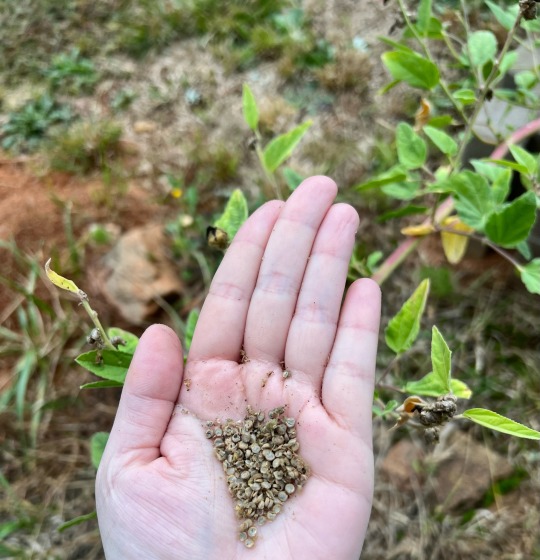
10/15/23 ~ Collected Marshmallow Root seeds from my plant! 😁
#collecting seeds#starting seeds#seed collecting#medicinal herbs#marshmallow root#seed saving#container gardening#sustainable gardening#vegetable gardening#veganuary#grow organic#grow your own food#tomato garden#organic gardening#plants and herbs#gardening blog
6 notes
·
View notes
Text

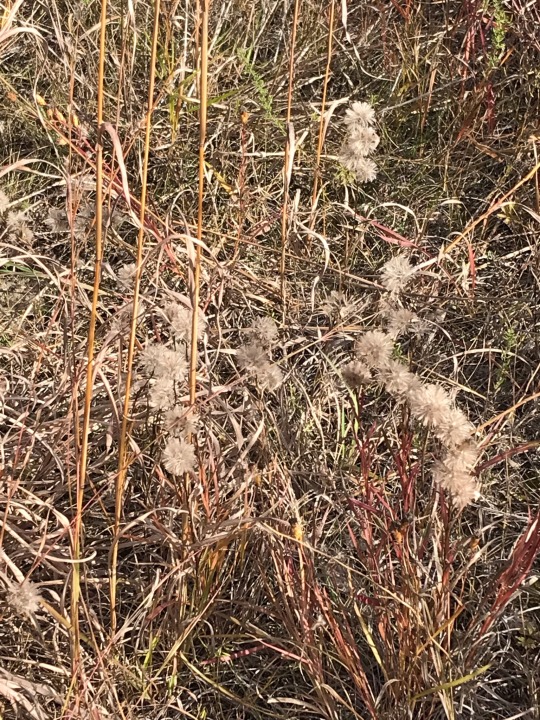

Met some cool tall grass prairie friends today doing seed collecting for a land trust: Canada wild rye, cylindrical blazing star, and little bluestem (with big bluestem in the background)
#personal#mine#ontario nature#seed collecting#tall grass prairie#I also accidentally collected about 143 showy tick trefoils seeds on my pants#ecology#enviro student shit
5 notes
·
View notes
Text

There is not a force in heaven or hell that will stop me from coveting the milkweed pods at the edge of the parking lot.
So plump, what are they doing with all that?
2 notes
·
View notes
Text


Harvested the Shepard's Purse today, the heart-shaped pods had a explosive dispersal mechanism and I realized that's why I lost some during the rain.
If I can grow more I plan on making tabouli with it instead of parsley. It has a little bite 😋
1 note
·
View note
Text

Opium poppy seedpods (papaver somniferum).
It’s seed saving time! Once the pods are brown and the seeds are black, they’re ready to harvest. You can eat the seeds. They’re not psychoactive and make lovely baked goods, or you can scatter the seeds in autumn or late winter to grow in the spring. Poppy seeds need to experience winter to germinate. Direct sow on the ground where you want them to grow because they don’t transplant well. Opium poppies are annuals and need to be started from seed each year anew.
#bane folk#opium poppy#Breadseed poppy#papaver somniferum#poppies#poppy seeds#seed saving#seed collecting#poisonous plants#toxic plants#medicinal plants#poison path#poison garden
50 notes
·
View notes
Text




Collected some baby sage seeds at the doctor's office today. Carpenter and bumble bees love the flowers.
0 notes
Text
Crocus Seed (Crocus vernus)
Did you know that crocus can send up little seed heads after the foliage has died back? because I didn’t until this spring. I don’t think I’ve ever seen this happen in previous years, but nearly every clump of crocus has done it this year. Whether I left it in the ground, or dug it up to move it. So what am I going to do? I opened up the seed pods of course and sprinkled them into a pot of…
#crocus#crocus vernus#garden#Gardening#grow from seed#grow your own#growing#saving seed#seed collecting#seed collection#seeds#Spring Crocus#spring fever
0 notes
Text

#he's collected all the korok seeds pls give him a nice smooch#zelink#the legend of zelda#tloz#loz#botw#totk
1K notes
·
View notes